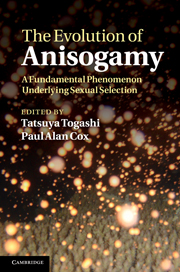Book contents
- Frontmatter
- Contents
- Contributors
- Introduction: The evolutionary mystery of gamete dimorphism
- 1 The origin and maintenance of two sexes (anisogamy), and their gamete sizes by gamete competition
- 2 The evolutionary instability of isogamy
- 3 Contact, not conflict, causes the evolution of anisogamy
- 4 Nucleo-cytoplasmic conflict and the evolution of gamete dimorphism
- 5 Adaptive significance of egg size variation of aquatic organisms in relation to mesoscale features of aquatic environments
- 6 Gamete encounters
- 7 Evolution of anisogamy and related phenomena in marine green algae
- Index
- References
7 - Evolution of anisogamy and related phenomena in marine green algae
Published online by Cambridge University Press: 19 May 2011
- Frontmatter
- Contents
- Contributors
- Introduction: The evolutionary mystery of gamete dimorphism
- 1 The origin and maintenance of two sexes (anisogamy), and their gamete sizes by gamete competition
- 2 The evolutionary instability of isogamy
- 3 Contact, not conflict, causes the evolution of anisogamy
- 4 Nucleo-cytoplasmic conflict and the evolution of gamete dimorphism
- 5 Adaptive significance of egg size variation of aquatic organisms in relation to mesoscale features of aquatic environments
- 6 Gamete encounters
- 7 Evolution of anisogamy and related phenomena in marine green algae
- Index
- References
Summary
INTRODUCTION
External fertilization is a reproductive strategy, common to invertebrates and algae in aquatic environments. In this chapter, we focus mainly on marine green algae, and as well as other algae if they are useful for understanding the evolution of anisogamy. In contrast to the consistency of oogamous animals, various types of mating systems from isogamy to pronounced anisogamy are observed in marine green algae; this facilitates comparisons of different reproductive strategies. This biological group, therefore, represents a superb opportunity to examine patterns of sexual allocation and gamete size versus a suite of ecologically relevant factors (e.g. dioecious versus monoecious life history, size of gametophytes, density of gametophytes in nature, and type of habitats). This study makes remarkable progress in the study of the evolution of anisogamy beyond theoretical speculation. If we know how the evolution of anisogamy happened, we might begin to see why it happened.
In green algae, the freshwater green algal order Volvocales has played an important role as the traditional testing ground for Parker, Baker, and Smith's model (hereafter the PBS model) (Parker et al., 1972, see also Parker's chapter, Chapter 1) (Knowlton, 1974; Madsen and Waller, 1983; Bell, 1985; Randerson and Hurst, 2001a). Although it is useful for study since this group has various types of mating systems from isogamy to strong anisogamy, it violates an important assumption of the PBS model. The PBS model assumes broadcast fertilization without any parental care.
- Type
- Chapter
- Information
- The Evolution of AnisogamyA Fundamental Phenomenon Underlying Sexual Selection, pp. 194 - 242Publisher: Cambridge University PressPrint publication year: 2011
References
- 12
- Cited by



